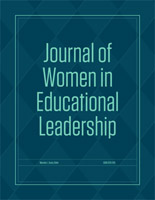Educational Administration, Department of

Journal of Women in Educational Leadership
Date of this Version
7-2008
Document Type
Article
Citation
Journal of Women in Educational Leadership, Vol. 6, No.3-July 2008 ISSN: 1541-6224
Abstract
The author profiles two women principals of color who have successfully enhanced student learning in high-poverty schools. In their leadership narratives, the principals address how the complexity of poverty affects their work, how they affirm the worth and dignity of all, how they influence beliefs and attitudes of staff, why they think their schools have been successful in raising student achievement, and their top three recommendations for how school leaders can most effectively improve the education of poor children. The author concludes with the recommendation that we pay attention to what these leaders know.
Introduction
When I moved to Peoria, Illinois, in 1990, I moved literally to poverty's edge. The first time I opened the privacy fence gate to put out the trash, I was surprised. Across the alley and directly perpendicular to my house was a street of tiny homes, examples of scattered site public housing. Almost immediately the two little girls who lived with their mother in the corner house on the right were in my yard, wanting to know who I was. Charise was six and wanted to help me plant flowers. Laneisha was nine, more serious, and just wanted to talk. I did not meet their mother Taunya until a few days later. Caring for her girls with love and vigilance, Taunya asked me lots of questions. Just because I was a college professor did not automatically mean the girls could spend time with me, I realized. Happily I passed Taunya's test, and the fence gate continued to swing both ways. This family put a face on poverty for me, allowed me into their struggles and joys. My understanding of the complexity of poverty deepened, and my beliefs and attitudes about people living on welfare and in low-income families changed significantly. I moved to Peoria to teach educational leadership at Bradley University, where I had many students who were teachers in the urban school district that serves Peoria. I became passionately interested in how principals lead schools that are successful in providing quality education for students from families living in poverty.


Comments
Copyright © 2008 Pro>Active Publications. Used by permission.